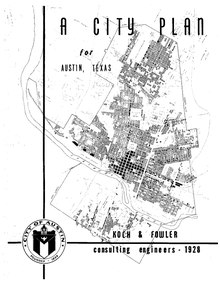
Back خطة شاملة Arabic Masterplan (Stadtplanung) German طرحهای شهری Persian Masterplan (urbanistica) Italian 総合計画 Japanese გენერალური გეგმა Georgian Structuurvisie Dutch Översiktsplan Swedish Nazım planı Turkish
This article needs additional citations for verification. (May 2015) |


Comprehensive planning is an ordered process that determines community goals and aspirations in terms of community development. The end product is called a comprehensive plan,[1] also known as a general plan,[2] or master plan.[3] This resulting document expresses and regulates public policies on transportation, utilities, land use, recreation, and housing. Comprehensive plans typically encompass large geographical areas, a broad range of topics, and cover a long-term time horizon. The term comprehensive plan is most often used by urban planners in the United States.
Each city and county adopts and updates their plan to guide the growth and land development of their community, for both the current period and the long term.[4] This "serious document"[5] is then the foundation for establishing goals, purposes, zoning and activities allowed on each land parcel to provide compatibility and continuity to the entire region as well as each individual neighborhood.[6] It has been one of the most important instruments in city and regional planning since the early twentieth century.[7]
- ^ "NYS Statute on Comprehensive Planning" (PDF). New York State. Retrieved February 3, 2022.
- ^ Fulton, William; Shigley, Paul (September 2012). Guide to California Planning (Fourth ed.). Solano Press Books.
- ^ Master Planning Archived 2020-09-29 at the Wayback Machine at The World Bank website. Retrieved 29 November 2021.
- ^ San Diego General Plan Update adopted March 10 2008
- ^ "What is a Comprehensive Plan". Westchester County. Retrieved February 3, 2020.
- ^ "New General Plan a balanced blueprint". Argus Courier. April 17, 2008.
- ^ Caves, R. W. (2004). Encyclopedia of the City. Routledge. p. 295.